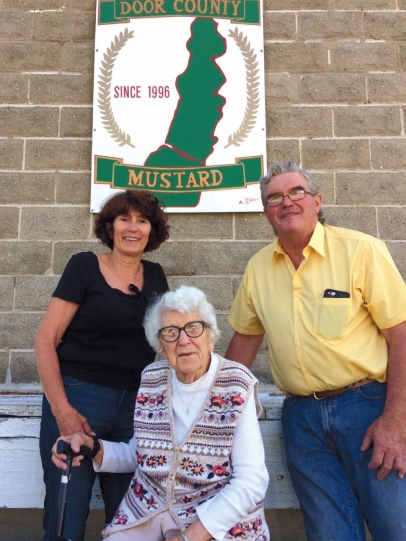These Hunts Known for Mustard, Not Ketchup
IT’S THE SEED THAT SETS THIS DOOR COUNTY PRODUCT APART
It’s available for sale at more than a dozen Door County markets and retail outlets because of its unique flavor and appeal. Followers of this traditional family recipe know it as the perfect dipping sauce on pretzels and beef sticks. Walk by farm market tasting tables or through retail stores displaying local products, and you’ll be sure to find this popular condiment. Once tasted, it is hard not to buy a jar of Door County Mustard.
Door County Mustard’s unique sweetness, combined with just the right amount of heat, creates a rich and enhancing flavor, especially when paired with salmon, baked ham, chicken or corned beef. The recipe has not changed in more than 20 years. The main ingredient is often mistaken for horseradish. However, according to Door County Mustard owners David and Rita Hunt, the secret to the “fire” is just the right mustard seed.
Unlike many other condiments, mustard has organic origins and is more highly regarded for its nutritional benefits. Seeds of the mustard plant are a rich source of minerals such as calcium,magnesium, phosphorous and potassium. Three different types of mustard varieties include white, brown and black. A precise combination of mustard seed, aided by a good growing season, achieves just the right favor that contributes to Door County Mustard’s very distinguishable taste.
“Most mustards on grocery store shelves are blended,” David said. “Our mustard requires cooking with other ingredients before bottling, and that is another unique difference.”
When friends and family encouraged the couple to begin marketing their mustard, David and Rita admitted they didn’t know how to expand their recipe from six cups to 50 gallons effectively. However, after retiring from sailing with Inland Steel in 1994, David started researching all facets of the mustard plant and toiled to achieve just the right flavor and consistency for larger batches. The family originally found a commercial kitchen and processor in Ladysmith, Wisconsin, in 1996 that could help make Door County Mustard and began building their wholesale business.
Growing the business has been a family affair. Rita’s sister is the founder of the recipe, while her mother, Audrie Watkins, is their favorite employee who helped the couple run the business until she retired four years ago at age 95.
“In the beginning we were bottling by hand,” Audrie said with a smile. “I remember squeezing the mustard into jar after jar.”
With the installation of an automatic bottler in 2013 and the purchase of a commercial location and kitchen located in Sturgeon Bay, this process improved immensely. The business now produces the same size batches April to October, ensuring quality and freshness, and then production slows as some retailers close for the winter.
When Audrie was a child growing up in Newport, just north of Ellison Bay, she remembers cherries (and the water) as being one of the first attractions for visitors to Door County. Now her family-inspired dipping sauce is a local favorite at many of the markets still known for their wonderful cherries.
Fridays are delivery days for David. The couple sells to approximately 17 retail outlets, primarily in Door County. Cases of jars of Door County Mustard are provided to clients; each case comes with samples.
David says he appreciates his relationships with quality market and retail owners who display Door County Mustard and provide free samples to their customers. This exposure, along with word-of-mouth and the popularity of the Door County brand, have contributed to the mustard’s popularity.
Renard’s Cheese features the product daily on their customer sampling table and according to assistant manager Gale DuFrane they can barely keep enough on the shelves. A family was in the store and commented that they needed “to buy enough to last a full year.”





